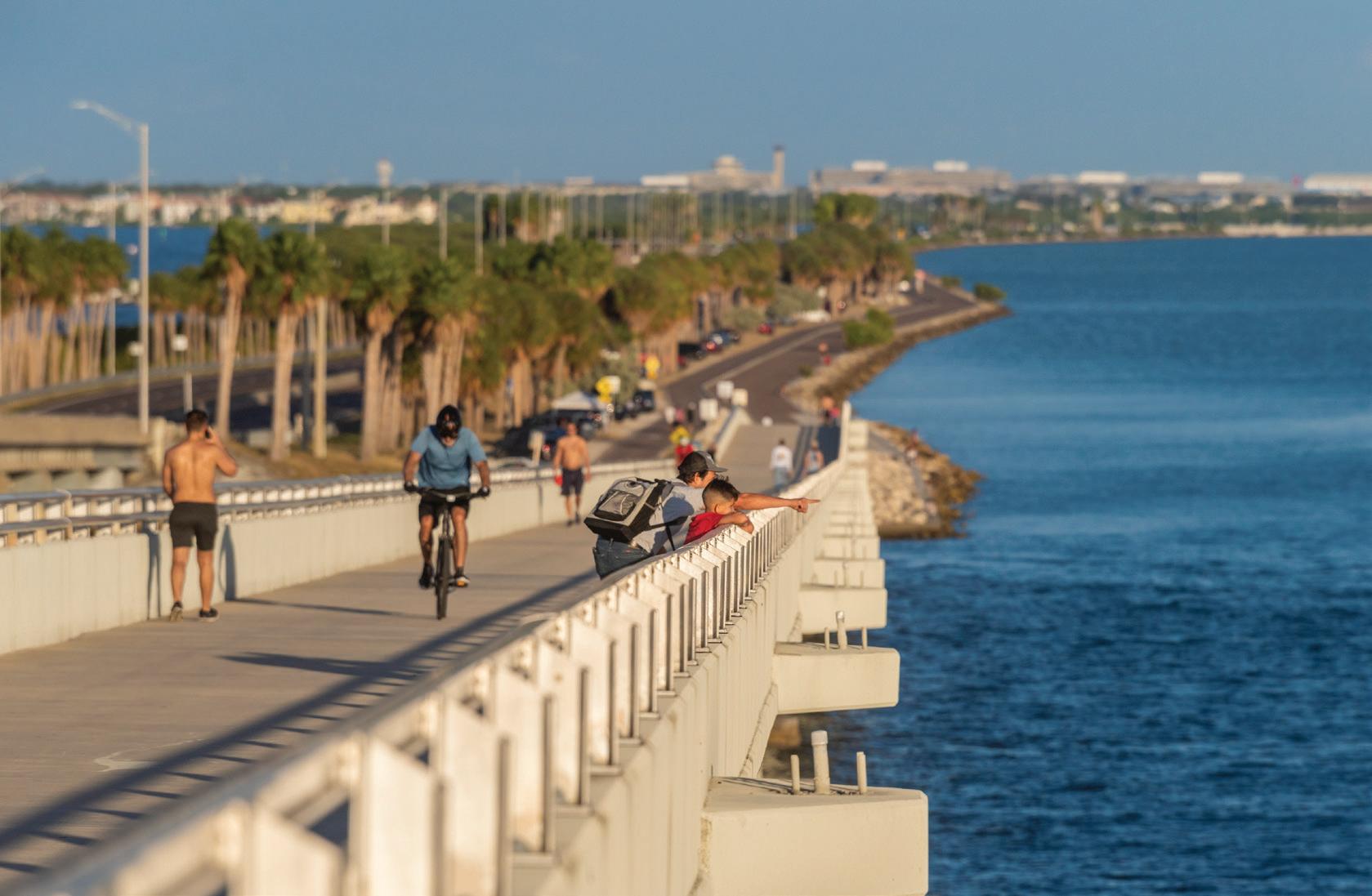










The Local Government Resource Guide (also known as the Resource Guide) provides essential information to help local governments effectively collaborate with the Florida Department of Transportation (FDOT or Department) in planning, designing, constructing, and maintaining safe and efficient transportation facilities. By working together, FDOT and Florida’s communities can establish a transportation system that aligns land use with infrastructure development on both local and regional levels. This collaboration is crucial in supporting Florida’s strong economy, preserving natural resources, and enhancing the quality of life for residents and visitors.
Florida communities engage in various planning efforts to assess their transportation infrastructure needs and priorities. These include local visioning projects, comprehensive plans, long range transportation plans, and modal plans. By establishing consistent partnerships early on, FDOT collaborates with local governments to advance local transportation projects, ensuring efficient project delivery, maximizing funding opportunities, and enhancing community strength throughout Florida. Ongoing collaboration during the phases of transportation planning, programming, and project delivery fosters partnerships that enable the effective implementation of projects tailored to local needs. These partnerships are crucial for ensuring the integration of land use and transportation planning at both local and regional levels.
This Resource Guide details essential elements of FDOT, including key offices, responsibilities, and an overview of Florida’s transportation planning, programming, and project delivery methods. It also explains the project development cycle, its various phases, typical timelines, and pertinent District contacts for assistance. The Resource Guide also identifies significant federal and state transportation funding sources and offers insights into project eligibility criteria.


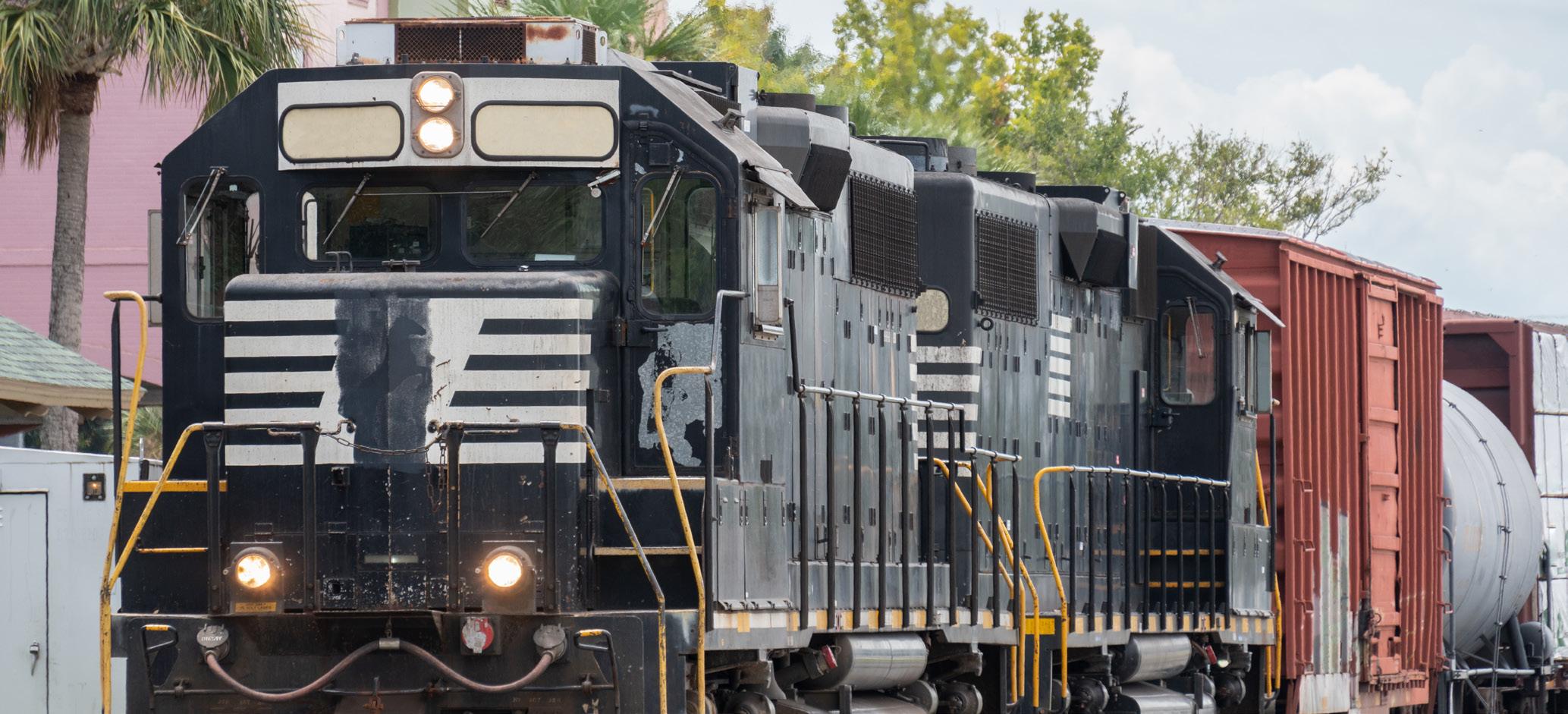
The mission of the Florida Department of Transportation is to provide a safe statewide transportation system that promotes the efficient movement of people and goods, supports the state’s economic competitiveness, prioritizes Florida’s environment and natural resources, and preserves the quality of life and connectedness of the state’s communities.
As one FDOT team, we serve the people of Florida by providing a transportation network that is well planned, supports economic growth, and has the goal of being congestion and fatality free.
As an executive agency, FDOT reports directly to the Governor. Serving all of Florida, FDOT’s primary role is to coordinate the planning and development of a safe, efficient state transportation system. FDOT also ensures compatibility between all modes of transportation including air, automotive, rail, sea, spaceports, public transportation, and bicycle and pedestrian facilities.
FDOT is a decentralized agency with a Central Office, seven Districts, and Florida’s Turnpike Enterprise, per Section 20.23, Florida Statutes (F.S.). The Secretary oversees FDOT, with a District Secretary managing each District and an Executive Director overseeing Florida’s Turnpike Enterprise. Central Office establishes policies, rules, procedures, and standards to support a consistent statewide approach across the Department. Each District has major divisions for Administration, Planning, Production, and Operations. Each District also has a Public Information Officer that reports to the District Secretary and a District Chief Counsel that reports to the FDOT General Counsel at Central Office. Florida’s Turnpike Enterprise, as a unit of FDOT, operates all FDOT-owned toll roads and bridges. For more information visit: www.fdot.gov/ agencyresources/organization.
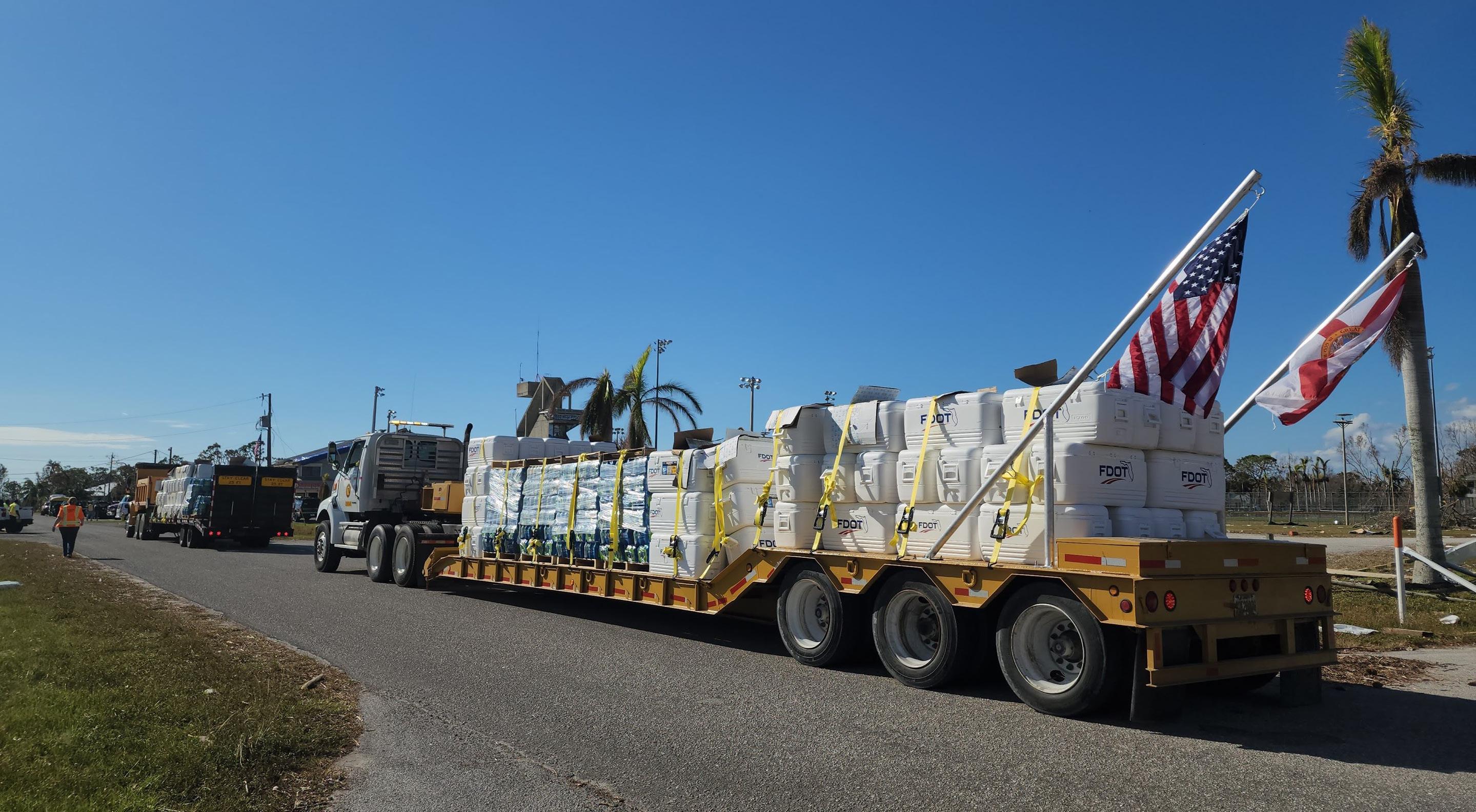
Per Section 339.155, F.S., and Title 23 Code of Federal Regulations (CFR), Section 450.216, FDOT develops and regularly updates the Florida Transportation Plan (FTP) in conjunction with state, regional, and local transportation partners in the public and private sectors. The FTP guides Florida’s transportation future by providing direction to all organizations that are involved in the planning and management of Florida’s transportation system.
The FTP is FDOT’s comprehensive statewide blueprint to guide Florida’s 30-year transportation future. The FTP’s transportation policy lays the foundation for all FDOT statewide plans and programs. Several of these plans and programs are described later in this Resource Guide in the Transportation Funding component. Visit www.floridaftp.com to learn about the current goals and objectives driving Florida’s transportation future.

Local governments, Metropolitan Planning Organizations (MPOs), and FDOT have distinct, yet complementary roles in Florida’s transportation planning and programming processes. MPOs and local governments prioritize projects, while FDOT programs project funding. Section 339.175(10) (a), F.S., codifies the coordination between FDOT and Florida’s MPOs.
Metropolitan Planning Organizations are responsible for coordinating the transportation planning process in urban areas with populations of 50,000 or more, as required by 23 CFR 450.310
Documenting that a project is a local priority should begin as early as possible. It is important for a local government’s comprehensive plan to reflect its transportation needs and priorities, especially in nonmetropolitan planning areas.
In MPO areas, local governments partner with MPOs to document future transportation needs in the MPO’s Long Range Transportation Plan (LRTP). An MPO’s highest priority, near-term needs are identified through its List of Priority Projects (LOPP), which feeds projects into the FDOT Work Program, the MPO’s Transportation Improvement Program (TIP), and the Statewide Transportation Improvement Program (STIP).
Section 163.3161, F.S., acknowledges the role of local governments in land use planning and mandates that they create and implement comprehensive planning programs to manage future growth and development. Furthermore, Section 163.3177, F.S., specifies that comprehensive plans must consist of various elements that deal with different facets of community development, including future land use, transportation, and capital improvements.
The FDOT Transportation Data Portal maintains information to support planning and development of Florida’s transportation system. Use the link below to explore its resources.
www.fdot.gov/data
The capital improvements element (CIE) aims to assess the need for and placement of public facilities, such as transportation infrastructure, in order to effectively implement the comprehensive plan. Pursuant to Section 163.3177(3), F.S., the CIE must:
» Encompass a minimum timeframe of five years.
» Be reviewed annually by the local government and updated through an ordinance.
» Include a schedule of capital improvements that identifies all publicly funded projects from federal, state, or local governments. Any projects essential for meeting adopted level-of-service standards within the 5-year timeframe should be specified as either funded or unfunded and assigned a priority for funding.
» Include in the schedule any transportation enhancements listed in the MPO’s TIP, if the local government operates within an MPO planning area. The schedule must also correspond with the MPO’s LRTP to ensure “planning consistency.”
Many local governments maintain a capital improvements plan (CIP) separate from, but based on, the schedule of projects outlined in the CIE. Annual updates to the CIP are used to modify the CIE as required. Regardless of the method chosen, the CIP and/or capital improvements schedule serve as vital communication tools for local governments to ensure their transportation needs and project priorities are considered in regional and state funding plans.
As outlined in 23 CFR 450.310, MPOs are federally-mandated and federally-funded transportation policy-making organizations that serve urban areas with 50,000 or more people. There are 27 MPOs in Florida, each with its own geographical boundary and board of voting members made up of representatives from local governments and transportation authorities. An MPO can include one county, multiple counties, or urban areas that do not encompass an entire county. It is also important to note that not all counties are within an MPO (see Nonmetropolitan Planning Areas). MPOs are sometimes called Transportation Planning Agencies (TPAs), Transportation Planning Organizations (TPOs), or other names. Regardless of how they are named, MPOs must carry out the following planning activities to qualify for and receive federal transportation funds.
The Long Range Transportation Plan (LRTP) is an MPO’s long-term strategic vision. Section 339.175, F.S., and 23 USC 134 require each MPO to develop an LRTP which serves as the foundation of a metropolitan area’s transportation vision over no less than a 20-year planning horizon. LRTPs include long and short-range strategies as well as transportation project priorities. A key part of the LRTP is the Cost Feasible Plan (CFP), which lists the MPO’s priority projects and demonstrates fiscal constraint, meaning the plan shows that projects can be implemented using available and forecasted revenues. The LRTP must be consistent with the FTP.
Section 339.175, F.S., requires each MPO to annually develop and submit a List of Priority Projects (LOPP) to their respective FDOT District. LOPPs link the LRTP to the TIP and are used to develop FDOT’s 5-Year Work Program and the STIP.
The Transportation Improvement Program (TIP) is an MPO’s short-term implementation of the LRTP’s long-term strategic vision. TIPs list the MPO’s funded projects for the next four years, as required by 23 CFR 450.218. In Florida, Section 339.175, F.S., requires TIPs to cover an additional fifth year for illustrative purposes. TIPs are updated annually and must be consistent with the MPO’s LRTP and the STIP.
The Statewide Transportation Improvement Program (STIP) is Florida’s short-term implementation of the FTP’s strategic vision. The STIP is a federally-mandated document that must include a listing of all projects planned with federal participation in the next four fiscal years. The STIP is essentially a compilation of every MPO’s TIP as well as projects from nonmetropolitan areas. FDOT updates the STIP annually, as required by 23 CFR 450.218 and Section 339.175, F.S.
23 CFR 450.308(b) requires MPOs to develop a Unified Planning Work Program (UPWP) to identify the planning priorities and activities to be carried out within a metropolitan planning area. At a minimum, a UPWP includes descriptions of planning work and resulting products, who will perform the work, timeframes for completing the work, the cost of the work, and the source(s) of funds. UPWPs must be updated every two years.
Nonmetropolitan planning areas are located outside of MPO boundaries and often include rural areas. In these areas, FDOT often works directly with local governments and elected officials.
Local elected officials from nonmetropolitan areas provide the District Offices with transportation project priorities based on their CIP and/or comprehensive plan CIE every fiscal year. These priorities are included, to the maximum extent feasible, in the District Work Programs. As there is no LRTP or TIP in nonmetropolitan areas, it is essential for local government project priorities to be included in the CIP and/or comprehensive plan CIE.

Florida-Alabama TPO
Okaloosa-Walton TPO
Bay County TPO
Capital Region TPA
Hillsborough TPO
Polk TPO
Indian River County MPO
Sarasota/Manatee MPO
Heartland Regional TPO
TPO
Gainesville MTPO North
Coast TPO Pasco County MPO Forward Pinellas
St. Lucie TPO
Martin MPO
Charlotte County-Punta Gorda MPO
Lee County MPO
Collier MPO
Palm Beach TPA
Broward MPO
Miami-Dade TPO
Section 186.504, F.S., designates the creation of regional planning councils (RPCs). RPCs support intergovernmental coordination and provide technical planning assistance to local governments. As such, RPCs may complete transportation planning projects and processes for both nonmetropolitan areas and MPO areas. They play a key role for some MPOs, sometimes acting as the government body to host the MPO.
There are 25 counties (or portions of counties) that are not within the boundaries of an MPO. Of Florida’s ten RPCs, five have nonmetropolitan areas within their boundaries. In these areas, RPCs often serve as liaisons between the District Office and rural communities, with several entering into Intergovernmental Coordination and Review (ICAR) agreements with FDOT to facilitate transportation planning within rural areas. RPCs may coordinate meetings with county staff and local elected officials to assist in the distribution of information and updates on transportation projects. They may also help gather timely input on the FDOT Work Program and other activities. RPC staff can work directly with county staff and rural municipalities in the region to help determine the transportation needs for each county.
By prioritizing transportation projects, communities are articulating their most important transportation needs. For MPO areas, prioritization is formalized through the development of the LOPP. Each MPO develops its own methodology for prioritization in coordination with all of its communities. For nonmetropolitan areas, FDOT works directly with local elected officials to determine priority projects.
Section 339.135, F.S., authorizes and sets the guidelines for FDOT to develop a Work Program annually. The Central Office and District Offices work together to develop and adopt the State Transportation 5-Year Work Program (the Work Program), a listing of all transportation projects planned by FDOT for the following five fiscal years. The District Offices each develop a District Work Program that Central Office combines into the Tentative Work Program. Each year, the new Tentative Work Program provides an update of the first four years of the existing Adopted Work Program and adds project programming for the new fifth year. For example, a Tentative Work Program being developed in the fiscal year beginning July 1, 2026 is for the next five fiscal years starting on July 1, 2027. The Tentative Work Program is presented to the Secretary, the Executive Office of the Governor, the Legislative Appropriations Committee, and the Florida Department of Commerce no later than 14 days after the regular legislative session begins. The Tentative Work Program is amended by the General Appropriations Act and any other applicable appropriations. Once FDOT adopts the Tentative Work Program, it is referred to as the Adopted Work Program. This Adopted Work Program is funded through a combination of sources, with approximately 25 percent coming from federal aid and the remainder from a mix of state funding, bonding, toll revenues, and local contributions. For the latest breakdown of Work Program funding by source, visit www.fdot.gov/workprogram.
The Work Program Cycle aligns with the schedule for Florida’s legislative session. In years ending in an even number, the legislature convenes in January. In odd years, it convenes in March.
The State Fiscal Year runs from July 1 to June 30, which differs from the federal and most local fiscal years that run from October 1 to September 30.
Tentative Work Program due no later than 14 days after legislative session begins
Project applications solicited by FDOT for new 5th year
Tentative Work Program
Public Hearings
The only way your project will make it into the FDOT Work Program is if FDOT knows about it through documented public engagement, project prioritization, and close collaboration with the FDOT District Office.

Section 339.61, F.S., established the Strategic Intermodal System (SIS) to enhance Florida’s economic prosperity and competitiveness and focus the State’s resources on transportation facilities of statewide and interregional significance. To be designated as part of the SIS, transportation facilities must meet criteria related to transportation or economic activity, as well as screening factors related to potential community and environmental impacts.
FDOT’s principal responsibility is the statewide and interregional movement of people and goods and shares responsibility with transportation partners in addressing system safety, the preservation and operation of transportation facilities, and local and metropolitan area transportation needs. As such, the SIS is FDOT’s highest transportation capacity investment priority. The SIS Policy Plan establishes the framework for these investments. FDOT is also increasing its focus on regional travel and facilities of regional significance. Consistent with Florida Statutes, FDOT Program and Resource Plan, and the FTP, FDOT allocates resources as follows:
» To preserve the investment which has already been made in the State’s transportation system. This includes funding for maintenance, bridge repair, bridge replacement, and resurfacing.
» To comply with statutes which specify how particular revenues are to be allocated. For example, documentary stamp tax revenues which are deposited into the State Transportation Trust Fund are to be used for the Small County Outreach Program, the SIS, the Transportation Regional Incentive Program, and the Rail Enterprise.
For more information on the SIS, visit the SIS webpage at www.fdot.gov/planning/systems/sis.
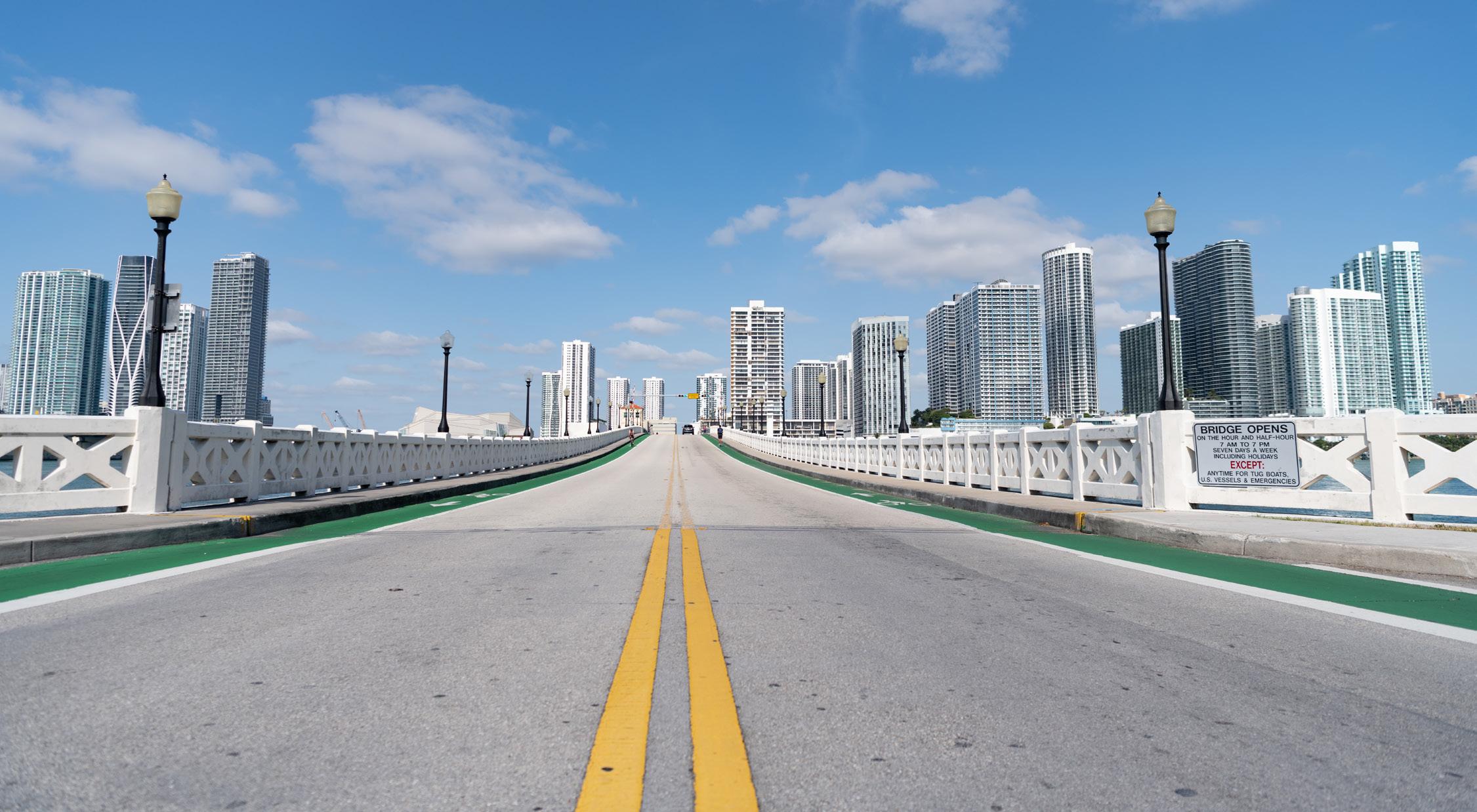
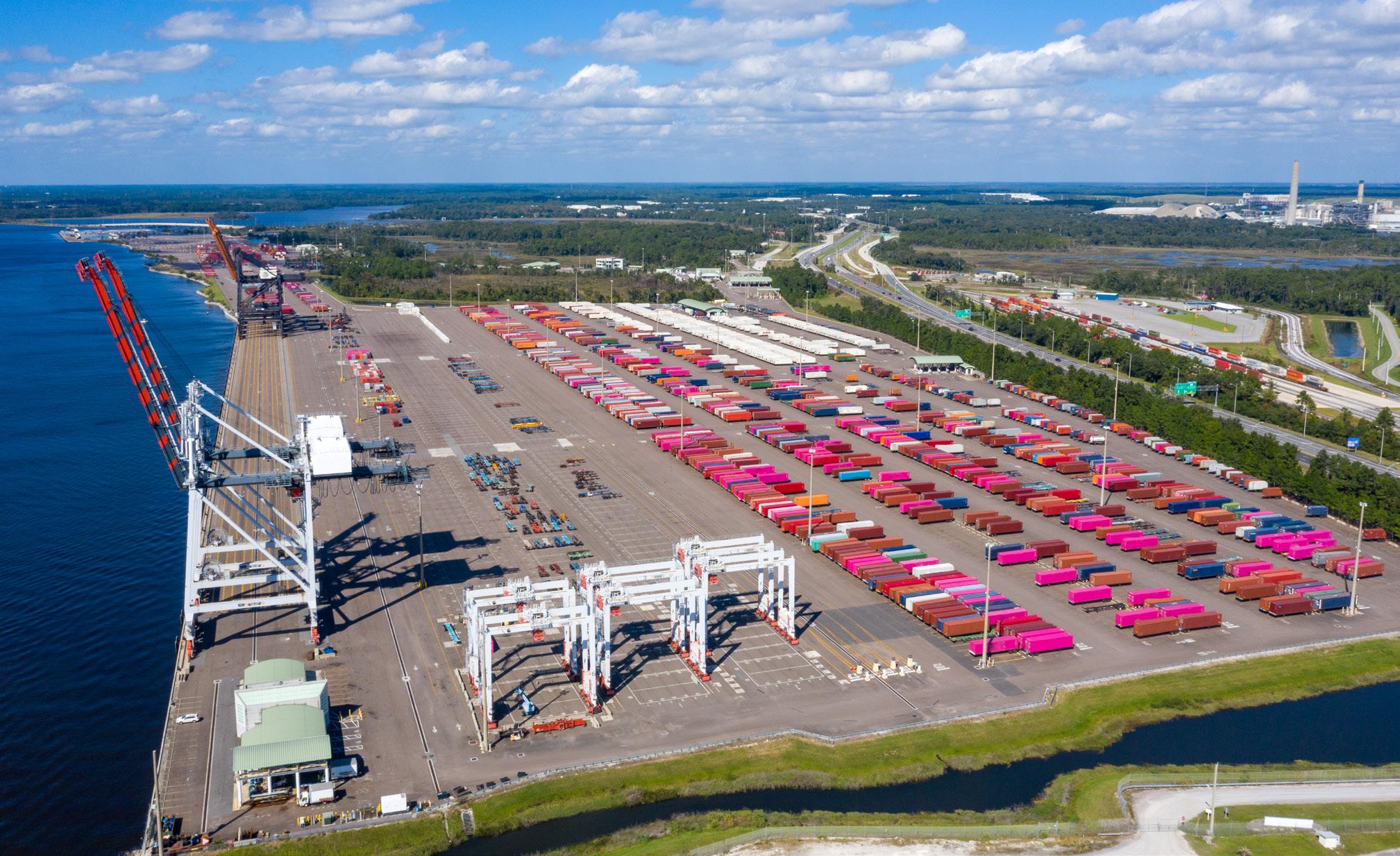
The Modal Offices facilitates and promotes the safe and efficient movement of people and goods by rail, sea, air, aerospace, and road. The Modal Development Offices maximize the use of existing facilities while integrating and coordinating the various modes, including the combined use of both publicly- and privately-owned resources.
In partnership with Districts, eligible MPOs and local governments, FDOT’s Modal Offices program funding into mode-specific CIPs that feed into the 5-Year Work Program. The Modal Programs include the following areas:
» The Public Transit Program supports fixed route, rail, and rural public transportation. For more information, visit www.fdot.gov/fdottransit/transitofficehome
» The Aviation Program provides assistance to Florida’s airports. For more information, visit www. fdot.gov/aviation
» The Freight and Rail Program assists in the development of Florida’s rail system, both passenger and freight, and championing Florida’s multimodal freight programs. For more information, visit www.fdot.gov/rail
» The Seaport Program provides funding and support for public ports. For more information, visit www.fdot.gov/seaport
» The Spaceport Program provides space transportation services and infrastructure in conjunction with Space Florida. For more information, visit www.fdot.gov/spaceport.
Community planning is the process of guiding the development of a community based on the needs and goals of its residents and businesses. It includes both land use and transportation planning, which together address how people and goods move through a community. When these two areas are well-integrated, they support the quality of life for our communities and the people who live there.
Land use decisions can directly influence transportation needs and infrastructure. For example, commercial zones might increase demand for freight access and traffic management. These planning choices affect the design and function of the transportation system.
Close collaboration between FDOT and Florida’s communities is essential. Working together ensures that transportation infrastructure aligns with local growth and development goals. This collaboration helps improve planning outcomes, supports community visions, and ensures that transportation systems remain safe, efficient, and responsive to future needs.
Under Florida’s Community Planning Act, FDOT is authorized to comment on issues that may adversely impact transportation resources and facilities of state importance. These include the SIS, State Highway System, National Highway System, and other state-owned and maintained transportation facilities.
For more information on FDOT’s Community Planning responsibilities, activities, and best practices, review the Community Planning Handbook at: www.fdot.gov/docs/communityplanninghandbook .
The District Community Planning Coordinator can assist with the connection between local land use and transportation planning. Using the contact information included in the online Resource Guide, you can request support for a variety of FDOT services, including technical assistance with comprehensive plans and amendments, support for Context Classification implementation, promotion of collaborative planning approaches, and expertise in transportation policy, planning, and implementation.
Visioning is the process through which the public and community elected officials can define a common future, typically establishing a shared purpose, core values, and a vision statement. Visioning is a useful step in the comprehensive planning process, but it may also occur independently. Visioning requires early and continuous community engagement in the planning process. FDOT encourages public outreach and formal vision adoption to gather input and strive for consensus among stakeholders before committing project funding.
A community conducts visioning at the beginning of the comprehensive planning process to establish consensus on the community’s shared vision for the future, informing the development of goals, objectives, and policies/procedures in the local comprehensive plan. This also includes the development of the CIP and CIE, which identify local transportation needs.
During the planning process, local planners may organize community meetings to develop a shared vision that results in action plans or projects. These action plans or projects define future desired community characteristics along with implementation steps and responsibilities. The community may use the shared vision to update the local comprehensive plan.
During the Planning Phase of the project development process, FDOT, a local government, or an MPO may conduct a feasibility study to evaluate aspects of a transportation project and understand the constructability of a project concept. This allows for early identification of project complexities that could be minimized, avoided, or mitigated throughout the project development process. This will be discussed later in the Resource Guide within the Transportation Project Development section on page 4-1.
Feasibility studies rely on transportation, land use, safety, and other planning data, as well as public and agency involvement, to establish a range of preliminary project alternatives. This helps ensure that only well-supported alternatives proceed to the next phase of project development. By identifying the most viable project options, feasibility studies can also help define the scope of work for the Project Development and Environment (PD&E) Phase of the project development process.
Feasibility studies may be conducted for nearly any transportation project type. Most frequently, FDOT uses feasibility studies to analyze corridors experiencing rapid growth, where stakeholder coordination contributes to potential future outcomes. The study effort involves the development of a feasible alignment and includes estimates of project costs and impacts, which is often documented in a subsequent master plan.
FDOT uses a context-based approach to planning, designing, and operating the state transportation network to “put the right street in the right place.” This approach promotes safety, quality of life, and economic development in Florida. The context classification of a roadway, together with its transportation characteristics and the built form, provides information about the expected users of the roadway, the regional and local travel volume, and the unique characteristics of each roadway user. The FDOT’s context-sensitive system comprises eight context classifications, which inform design criteria such as target speed, design speed, and bicycle and pedestrian facility options. FDOT confirms the context classification at the beginning of each project phase, including the Planning Phase.
FDOT District Offices, in coordination with local governments and MPOs, utilize an interdisciplinary team to determine context classifications by reviewing local comprehensive plans, subarea plans, land development regulations, zoning, and other similar planning tools. To learn more about context classification, visit www.fdot.gov/docs/context-classification or the ConnectPed Public webmap
C1-Natural
Lands preserved in a natural or wilderness condition, including lands unsuitable for settlement due to natural conditions.
C2T-Rural Town
Small concentrations of developed areas immediately surrounded by rural and natural areas: includes many historic towns.
C3C - Suburban Commercial
Mostly non-residential uses with large building footprints and large parking lots within large blocks and a disconnected or sparse roadway network.
C5 - Urban Center
Mix of uses set within small blocks with a well-connected roadway network. Typically concentrated around a few blocks and identified as part of a civic or economic center of a community, town, or city.

C2-Rural
Sparsely settled lands; may include agricultural land, grassland, woodland, and wetlands.
C3R - Suburban Residential
Mostly residential uses within large blocks and a disconnected or sparse roadway network.
C4 - Urban General
Mix of uses set within small blocks with a well-connected roadway network. May extend long distances. The roadway network usually connects to residential neighborhoods immediately along the corridor or behind the uses fronting the roadway.
C6 - Urban Core
Areas with the highest densities and building heights, and within FDOT classified Large Urbanized Areas (population >1,000,000). Many are regional centers and destinations. Buildings have mixed uses, are built up to the roadway, and are within a well-connected roadway network.
Multimodal transportation planning considers the broader transportation network and develops solutions that offer a comprehensive range of transportation options. This approach works to ensure safe and efficient facilities for all forms of transportation. FDOT and its transportation partners engage in multimodal planning to define problems, identify the purpose and need, determine the modes to be served, establish evaluation criteria, and compare a variety of alternatives. Outcomes of these studies often include transportation improvements, land use strategies, or a combination of both. Solutions may consist of capital projects, operational adjustments, and maintenance plans tailored to various transportation types. Land use strategies can involve detailed land use plans and other planning tools.
For example, MPOs and local governments may develop bicycle and pedestrians plans that focus specifically on these modes. These types of plans can be master plans, area specific plans, policy plans, or others. While developing these plans, the MPO or local government is encouraged to partner and coordinate with FDOT.
Mode-specific plans play a critical role in this process by guiding decisions about future investments and providing policy and guidance for each transportation mode, rather than for an individual project. These plans are essential for leveraging federal and state resources and ensuring consistency across planning efforts. For example, projects

for aviation, rail, seaports, and spaceports are typically identified through the development of facilityspecific master plans. These plans include CIPs that define necessary capital projects. To ensure alignment with broader transportation goals, these projects should be incorporated into local and regional planning documents such as local government comprehensive plans or an MPO’s LRTP. Once integrated, they can be programmed for funding through the FDOT District Office and the appropriate modal sponsor, such as an airport authority.
An example modal plan is the Freight Mobility and Trade Plan (FMTP), which serves as the state’s freight plan under the National Highway Freight Program (NHFP). The FMTP identifies freight transportation facilities critical to economic growth and guides both short- and long-term multimodal freight investments. FDOT develops this plan with input from the freight industry, local governments, MPOs, and other state agencies. To view the FMTP, visit www.fdot.gov/rail/plandevel/freight-mobility-and-trade-plan
The Transportation Systems Management and Operations (TSM&O) Program promotes multimodal traffic management projects and services that improve roadway operations. It is a national initiative that is supported statewide and allows FDOT to work with partner agencies to deliver multimodal solutions to reduce congestion. The goal is to equip the existing roadway system with innovative tools and techniques that will optimize performance for current and future traffic demand. Visit www.fdot.gov/traffic/its/tsmo. shtm to learn more about TSM&O.
Access management is the coordinated planning, regulation, and design of access between roadways and land development. It promotes the efficient and safe movement of people and goods by reducing conflicts on the roadway system and at its interface with other modes of travel. FDOT developed the Multimodal Access Management Applications Guidebook to help state and local transportation officials to understand access management and standards that are used to develop and design access to state transportation facilities, like state roads. FDOT also uses this guidance to issue driveway permits on these facilities. For more information and resources, see the FDOT Access Management website at www.fdot.gov/planning/ systems/systems-management/access-management.
FDOT, MPOs, and local governments work to provide meaningful opportunities for engagement when developing transportation plans and projects. Community engagement activities occur during all project phases that result in collaborative transportation solutions that incorporate local preferences and views in key decisions. Proactive, community-based activities enhance relationships and strengthen partnerships with all those who are involved in the transportation process.
Engagement opportunities for transportation plans and projects are available to community members through a wide range of options which may include participation on local boards and advisory committees; attendance at in-person and virtual public meetings, workshops, and open houses; and using virtual 3D technology, social media, surveys, and news releases. To learn more about FDOT’s approach to community engagement, visit www.fdot.gov/planning/policy/community-engagement.
FDOT and its partners implement a variety of practices to support transportation planning, project development, and project delivery. These practices help create a transportation system in Florida that is safer, more efficient, and better connected. The practices described in this section are just a few of the ways that FDOT works with local partners to plan and design transportation system improvements that benefit Florida’s communities.
The project development and delivery process comprises several phases, and the level of effort required for each phase varies depending on the individual project. These phases and their typical timeframe are described below, along with strategies for expediting project delivery. There are several project delivery approaches, with options available for organizations that want to administer their projects, provided they meet specified criteria for certification.
Local governments that partner with FDOT early in the planning process can help establish a shared understanding of where the project may enter the development and delivery process. Early engagement often facilitates efficiency in advancing the project. Moreover, providing supporting information such as documented community engagement, a resolution signed by the relevant council or commission, or a feasibility study, helps communicate project readiness to FDOT. If applicable, local governments should coordinate with their MPO to ensure projects are programmed in the relevant LOPP.
The project development and delivery process typically begins with planning studies and concludes with the construction of a project. The FDOT’s project development and delivery process is comprehensive, involving the following phases: Planning, Project Development and Environment (PD&E), Design, Right of Way (ROW), Construction, and Maintenance and Operations. It is essential to understand the sequence and interrelationship between these phases to deliver a project efficiently.
Overview of project development cycle and phases:
PLANNING (1-2 years)
Identifies long range transportation goals; conducts work program meetings with local governments; identifies project purpose and need; may identify preliminary alternatives and initial feasibility.
PD&E (2-3 years)
Documents the need for the project; refines and provides additional data to justify purpose and need; develops alternatives to meet the need; evaluates environmental impacts; considers input from the public.
DESIGN (1-3 years)
Surveys land; prepares construction plans; identifies ROW requirements.
RIGHT OF WAY (2-3 years)
Acquires the needed property; provides relocation assistance; conducts demolition of structures.
CONSTRUCTION (2-5 years)
Oversees project construction; conducts inspection of materials.
MAINTENANCE & OPERATIONS (ongoing)
Maintains facility throughout its design life: lighting, pavement, roadsides, spills, signs, etc.
The complexity of transportation projects varies greatly; therefore, the timeframes in the project development process graphic are broad and general in nature. Less complex projects that do not have ROW considerations, have little environmental impact, or are not federally funded may move more quickly through the project development and delivery process. Moreover, some projects may start at the Planning Phase, while others may be able to move directly into the PD&E or Design phases. These timeframes are typical, but each project is different, and a variety of factors, including securing funding, can impact the length of a project phase.
A developer or local government can accelerate project implementation by contributing to or fully funding a project phase. The additional funding enables continuous progress through the project development and delivery process.
Reminder: Transportation projects often begin with planning, so if a local government has a high-priority project or idea, it is best to approach the FDOT District (or MPO if in an MPO area) with that idea to begin the planning process.
The planning process begins when FDOT, MPOs, local governments, and other authorities identify long range transportation goals and priority transportation projects in planning documents that assist in conveying local transportation needs. FDOT annually selects priority projects from these plans and presents them to the Florida Legislature as a Tentative Work Program. Identification of a project’s purpose and need also begins in the Planning Phase and can be further refined during the subsequent phase.
The Project Development and Environment (PD&E) Phase is FDOT’s process for evaluating potential transportation project impacts and complying with the National Environmental Policy Act (NEPA) and other applicable laws and regulations. This phase is generally only required for major projects (such as widening, new alignment, or interchanges), especially those with federal funding. Projects that do not include a PD&E Phase will move directly from Planning to Design, with the first stages of design often referred to as Preliminary Engineering.
A PD&E study ensures early consideration is given to operations, safety, engineering design, project costs, and environmental and community impacts in the development of a proposed transportation project. During this process, project alternatives are developed with input from the public, local government, and environmental and planning agencies. These alternatives are analyzed to determine their involvement with the social, natural, and physical environment. The goal of the PD&E process is to select the alternative that meets both the purpose and needs of the project, while having the least impact on the environment. It should be noted that the PD&E Phase is not always necessary for projects that do not cumulatively have a significant environmental effect. Refer to Part 1, Chapters 2 and 10 the FDOT PD&E Manual for more information and required documentation.
Public involvement during the PD&E Phase begins with the preparation of a Public Involvement Plan (PIP). The purpose of a PIP is to identify the interested people within a community, document community characteristics, and define the outreach methods and schedule to gain input.
During the PD&E Phase, FDOT confirms the future context classification(s), performs alternatives analyses,
What factors influence project design and construction time?
The length of each project phase may vary based on factors such as funding, priority, workforce capacity, permitting, and complexity.
What is a Community Awareness Plan?
A Community Awareness Plan outlines an approach for notifying local government, nearby property owners, and the public of the proposed design and construction.
How do you incorporate community aesthetic features into an FDOT project?
The local government may elect to contribute funds during the PD&E, Design, or Construction phases of a project. However, FDOT may not be responsible for the maintenance.
How do you add landscaping to an FDOT project?
Contact the District Design Office as it may be possible to acquire landscaping funding. Note, a Landscape Maintenance Agreement may be necessary.
Who can you contact for state road speed limit change requests?
Contact the District Traffic Operations Engineer.
How can we add sidewalks to a state roadway?
Sidewalks may already be required based on the context classification of the roadway. If not, or if non-standard sidewalks are desired, a community may apply for an enhancement project. If a project is in the Design Phase, contact the District Design Office as soon as possible.
conducts environmental studies, and prepares various technical studies and reports necessary to obtain the project’s Location and Design Concept Acceptance (LDCA). Information obtained during the PD&E Phase is used to develop the scope of work for the Design Phase. There are distinct differences between federal, state, local, and privately funded projects depending on anticipated funding sources. For more information on PD&E studies, visit FDOT’s PD&E Manual at www. fdot.gov/environment/pubs/pdeman/
The purpose of the Design Phase is to prepare detailed, context-based engineering design, contract plans, specifications, and estimates for the project based on the physical and environmental analysis conducted prior to this phase. The review of design and construction plans for design-bid-build projects (conventional projects) follows a standard four phase submittal approach to facilitate review of the projects. Prior to authorization to advertise the project for construction, the project may undergo an environmental re-evaluation to ensure that there are no conditions in place that would alter the original approval of the decision and commitments made during the PD&E study. Community engagement activities during the Design Phase typically begin by preparing a Community Awareness Plan (CAP) and may involve activities such as public information meetings or a design public hearing. The CAP outlines a process for determining design implications, lists FDOT’s commitments, provides opportunities to address public concerns, and develops a Temporary Traffic Control (TTC) plan, also known as a Maintenance of Traffic (MOT) plan, for use during construction. For more information on the Design Phase, visit www.fdot.gov/design.
An important resource for local governments is FDOT’s Manual of Uniform Minimum Standards for Design, Construction, and Maintenance for Streets and Highways, more commonly known as the Florida Greenbook. The Florida Greenbook provides the minimum standards and design criteria for public roads in Florida that are not a part of the state or
national highway systems, as these systems require compliance with the FDOT Design Manual (FDM). The Florida Greenbook encourages context-based transportation planning and design that uses existing tools in creative ways to continually improve Florida’s transportation system for all users, including pedestrians, bicyclists, public transportation riders, motorists, and freight handlers. Local government planners and engineers can consult the Florida Greenbook when planning and designing local roads to ensure their transportation facilities meet minimum requirements. For more information about the Florida Greenbook, visit www.fdot.gov/ roadway/floridagreenbook/fgb.
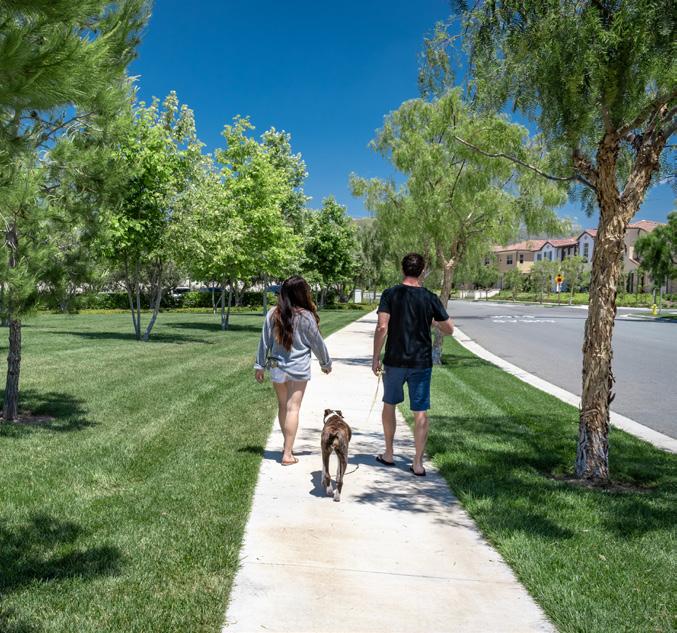
During the Right of Way (ROW) Phase, land required for transportation purposes is acquired to ensure sufficient space for construction and future operations. When proposed improvements fall outside of the existing ROW, additional property must be acquired through purchase or donation. At the state level, this process requires close coordination with the FDOT ROW Office and Office of the General Counsel to ensure legal and procedural compliance. For more information, visit www.fdot.gov/rightofway

After design plans are reviewed, commented on, approved, and permitted, the project goes through the contracting or letting process where it is awarded to a contractor. Once an award letter is issued to a contractor, several preconstruction activities are required pursuant to the Construction Project Administration Manual (CPAM), including scheduling a preconstruction conference, developing a construction schedule, preparing final estimates, and creating quality control procedures. For more information about the CPAM, visit www.fdot. gov/construction/manuals/cpam. During construction, contractors are responsible for building the project as well as providing necessary documentation for payment. The Department’s construction team keeps a project diary to document daily activities during the Construction Phase. This team is also responsible for ensuring that the project is built to the Department’s standards and specifications. For more information on the Construction Phase, visit www.fdot.gov/construction
During the Maintenance and Operations Phase, the Department is responsible for ensuring that all roadways on the State Highway System, including interstates, remain safe, functional, and well-maintained. This includes maintaining pavement, signage, striping, sidewalks, and roadsides, as well as inspecting and maintaining bridges, culverts, and sign structures. FDOT also conducts routine inspections of locally owned bridges. In addition to regular maintenance activities, the Maintenance Office plays a vital role in emergency response during storm events and traffic incidents. While local governments are responsible for maintaining local roads, FDOT may assist with emergency restoration of roads and bridges when authorized through an approved mission. For more information, visit the Maintenance Office at www.fdot. gov/maintenance.
The FDOT Work Program is a transparent, bottom-up effort where the Department’s local partners determine their top eligible priorities for inclusion in the Work Program. Federal, state, and local partners contribute to funding transportation projects in Florida. FDOT administers state and federal funds through the 5-Year Work Program, while local communities contribute funds by way of their local government. All funding programs administered by FDOT are included within the Work Program.
Local governments should consider important factors like project readiness and phase of work when identifying eligible funding programs. Local funding options may also be a viable or complementary source of funding to support a local transportation improvement.
Section 334.044, F.S., allows FDOT to assume the responsibility for coordinating the planning of a safe, viable, and balanced state transportation system serving all Florida regions and to assure the compatibility of all components, including multimodal facilities. FDOT adopts a 5-Year Work Program, listing transportation projects planned for each fiscal year, to carry out these duties. State taxes and fees, as well as federal aid, comprise the primary funding sources of the Work Program. See the Florida’s Transportation Tax Sources document for more information at https://bit.ly/3ZYb8Cs.
FDOT Local Programs provide transportation resources for the construction, resurfacing, and rehabilitation of roadways and structures authorized by Section 339.2816 through 339.2819 and Section 339.28201, F.S. Different local programs and grants have individual criteria and requirements, and local governments should contact their respective FDOT District Administrator identified on the applicable key District contacts web page to become familiar with the programs.
County Incentive Grant Program
Section 339.2817, F.S., created the County Incentive Grant Program (CIGP) to provide grants to counties to improve transportation facilities located on the State Highway System or that relieve traffic congestion on the State Highway System.
Section 339.2818, F.S., establishes the Small County Outreach Program (SCOP) to assist small county governments in repairing or rehabilitating county bridges, paving unpaved roads, addressing roadrelated drainage improvements, resurfacing or reconstructing county roads, or constructing capacity or safety improvements to county roads. Funds are available to counties that have a population of 200,000 or less.
Small County Outreach Program for Municipalities and Communities
SCOP Municipalities and Communities is available to local governments within a Rural Area of Opportunity (RAO), designated under Section 288.0656(7)(a), F.S., to assist in the repair and rehabilitation of bridges, paving unpaved roads; addressing road-related drainage improvements; resurfacing or reconstruction of roads and constructing safety improvements to roads. A local match is not required for projects awarded under this program.
County Road Assistance Program
Section 339.2816, F.S., created the Small County Road Assistance Program (SCRAP) to assist small county governments in resurfacing or reconstructing county roads. Funds are available to counties that have a population of 75,000 or less. The primary criterion for this program is the physical condition of the road, and secondary measures include whether or not the roads are evacuation routes, considered a main arterial route or feeder road, impact the public road system, or impact the state or local economy.
Regional Incentive Program
Section 339.2819, F.S., created the Transportation Regional Incentive Program (TRIP) to provide funds to improve regionally significant transportation facilities in regional transportation areas defined by Florida Statutes. State funds also are available to provide incentives for local governments and the private sector to help invest in critically needed projects that benefit regional travel and commerce.
Agencies may partner via an interlocal agreement to plan, prioritize, and deliver regionally significant projects in the boundaries of their regional transportation area. For more information, refer to the TRIP fact sheet available at www.fdot.gov/ docs/tripfactsheet2019
are eligible for State Infrastructure Bank (SIB) loans, provided the project is matched by a minimum of 25 percent from funds other than SIB. The SIB is discussed further on page 5-6.
For more information on Local Programs, reach out to the Local Program Administrator in your District’s Local Program Office: www.fdot.gov/ programmanagement/lp/lpcontacts.shtm
The Local Agency Program (LAP) is a mechanism through which local governments receive federal funds to develop, design, and construct transportation facilities. FDOT administers these funds on behalf of the Federal Highway Administration (FHWA). LAP is a delivery method, not a fund type, meaning that FDOT can manage several types of funds through this program including:
» The Emergency Relief Program
» Off-system Bridge Replacement
» Federal Lands
» Transportation Alternatives
Benefits of LAP include:
» Increases availability of funds for local agencies to perform transportation projects
» Introduces federal aid to fund local roads that are not part of the State Highway System
» Allows local agencies to retain control of project management
FDOT uses LAP Agreements to deliver federal funds to a LAP-certified agency. Agreements include the detailed project description, scope, schedule, services, deliverables, commitments, maintenance responsibility, and cost estimates. In order to participate in LAP, local government agencies must become certified by completing a series of assessments to ensure financial and staffing capability, as well as the ability to comply with federal and state regulations. Project delivery options include LAP certification of the local government or agency entity or project delivery by another LAP-certified agency. To learn more about LAP certification and eligible projects, visit www.fdot.gov/programmanagement/lap/ default.shtm
» Do you proactively work with your MPO or governing board to identify those prioritized projects that best fit the federal delivery method?
» Does the project require ROW acquisition?
» Does the project require environmental mitigation or NEPA-related actions?
» Have you considered Americans with Disabilities Act (ADA) Design Accessibility?
» Are you prioritizing low cost projects? Is there a way to bundle multiple low cost projects to maximize federal funding?
» Have you thought about spacing out delivery of high-dollar, high-risk projects to prevent overextending agency staff resources?
The Florida Grant Application Program (GAP) is a secure, web-based system that allows the Department to host and manage state grant programs online. GAP allows local governments to submit applications online and, after funding is awarded, manage the funding, track budgets, and request reimbursements. The system prevents data duplication and ensures efficient progress tracking throughout the life cycle of a grant program for both the grantor and grantee.
Additionally, GAP serves as the document review portal for Florida’s 27 MPOs. The MPO document portal inside the GAP system facilitates the review and approval of the three major documents created by the MPOs: LRTPs, TIPs, and UPWPs. The GAP system allows MPOs to submit documents to be reviewed and approved in the GAP system by multiple agencies. The system can be accessed at the following link by selecting “Request User Access” at https://secure.blackcatgrants.com/login.aspx?site=flgap


Through the Transit Program, the FDOT Public Transit Office supports local public transportation programs by administering federal and state public transportation grants including:
» Section 5305 -- Program that funds the Metropolitan Planning Program and the State Planning and Research Program. Note that in Florida, 5305(d) funds are combined together with the MPO’s Planning (PL) funds as part of the Consolidated Planning Grant.
» Section 5307 -- Formula program that funds capital and operating assistance in urban areas with 50,000 or more people.
» Commuter Assistance Program
» Park and Ride Lot Program
» Service Development Program
» Section 5310 -- Programs for capital projects that are planned, designed, and carried out to meet special needs of elderly and individuals with disabilities.
» Section 5311 -- Formula program that funds capital and operating assistance in rural areas.
» Section 5339 -- Buses and Bus Facilities Grants Program.
» State Block Grant Program
» State New Starts Program
» Transit Corridor Program
This funding may support capital or operational cost funding. Public transportation agencies may operate local rail, ferry, and bus programs, while local governments and non-profit agencies often support paratransit programs such as “dial-a-ride” for users who cannot use standard fixed route systems. For more information, please visit www.fdot.gov/fdottransit/transitofficehome
While bicycle and pedestrian projects may be funded through various sources or incorporated into larger projects, the following programs are key avenues through which FDOT and its partners distribute funding across the state.
The Transportation Alternatives Set-Aside Program (TA) funds are from a continuation of the Surface Transportation Block Grant (STBG). Projects and activities can only receive funding after competitive solicitation cycles. TA funds are apportioned to states based on a federal formula. Except for Turnpike Enterprise, Districts receive apportionments of the statewide TA allocation. TA funding is used for projects and activities that improve conditions and expand and integrate accessible nonmotorized travel choices,
including bicycle and pedestrian facilities, recreational trails, safe routes for non-drivers, vulnerable road users, Safe Routes to School (SRTS), and improvements to help achieve accessibility for compliance with the Americans with Disabilities Act of 1990 and Section 504 of the Rehabilitation Act of 1973. TA also funds cultural, historical, and environmental aspects of surface transportation infrastructure. It is FDOT policy to provide “soft” matches with toll credits to supplement federal TA funds in lieu of requiring non-federal funds. For more information about TA, visit www.fdot.gov/planning/systems/systems-management/tap
Reminder: All financial assistance programs administered by FDOT are reimbursement programs. Grantees must have available funds to pay for project costs when the grant disbursement agreement is executed.
In addition to the Districts’ apportionments, other partners administer TA funding. One of the suballocations is the Recreation Trails Program (RTP), overseen by the Florida Department of Environmental Protection (FDEP). Transportation Management Areas (TMA) also oversee and have obligation authority for a suballocation of TA funding. They may use up to half of their total suballocation for other surface transportation eligible purposes, not just TA eligible activities.
Safe Routes to School (SRTS) is focused on planning, design, and construction of infrastructure-related projects that will substantially improve the ability of students to walk and bicycle to school. The projects should directly support increasing safety and convenience for school children in grades K-12 to bicycle and/or walk to school. For more information, visit www.fdot.gov/Safety/programs/safe-routes.shtm
Implementing projects in the SUN Trail network increases the reliability of Florida’s transportation system.
Section 339.81, F.S., established the Shared-Use Non-motorized (SUN) Trail program, which provides funding to help communities develop a statewide system of paved multi-use trails for bicyclists and pedestrians. Including a combination of existing, planned, and conceptual multiple-use trails, SUN Trail is a component of the Florida Greenways and Trails System (FGTS) Plan. For more information on the SUN Trail program, visit www.fdot.gov/planning/systems/systems-management/SUNTrail.
Florida is a national leader with its comprehensive approach to traffic safety, demonstrating unwavering commitment to protecting lives on its roadways. The state’s safety programs and strategies work together to reduce traffic fatalities and serious injuries across Florida’s transportation system.
FDOT awards subgrants to traffic safety partners undertaking priority area programs and activities to strengthen the overall approach to safety and reduce crashes, serious injuries, and fatalities. Subgrants are awarded to state and local agencies to assist in the development and implementation of programs in traffic safety priority areas. The National Highway Traffic Safety Administration (NHTSA) apportions funding to states annually according to a formula based on population and road miles.

Government agencies, political subdivisions of state, local, city, and county government agencies, law enforcement agencies, state colleges and state universities, school districts, fire departments, public emergency service providers, and certain qualified non-profit organizations are all eligible applicants. For more information including the funding cycle and project application process, visit www.fdot.gov/Safety/ grants.
The Strategic Highway Safety Plan (SHSP) is a transportation safety plan for ALL of Florida with a vision of eliminating fatalities and serious injuries on Florida’s roadways. To view the plan, visit www.fdot.gov/Safety/shsp/shsp.shtm.
The Highway Safety Improvement Program (HSIP) is FDOT’s largest source of safety improvement funding, and the purpose of the HSIP is to reduce fatalities and serious injuries on ALL public roads.
An HSIP-funded project may include strategies, activities, and capital projects on a public road that are consistent with the HSIP and correct or improve a hazardous road location or feature or address highway safety. To read more about the HSIP in the Florida HSIP Guidelines Manual, visit www.fdot.gov/Safety/ safetyengineering/reports-and-plans
The Railway Highway Crossings (Section 130) Program allows FDOT to fund railway-highway safety projects. For more information on FHWA’s Railway Highway Crossing Program, visit https://bit. ly/3I8ydw7.
The following programs may assist local governments in funding projects through loans, match waivers for state funding, or state-funded appropriations from the state legislature.
Sections 339.55 and 215.617, F.S., create the Florida State Infrastructure Bank (SIB) and the bonds for the Florida SIB. This revolving loan and credit enhancement program can provide loans and other assistance to public and private entities carrying out or proposing to carry out projects eligible for assistance under state and federal law. To learn more about the SIB, visit www.fdot.gov/comptroller/pfo.
The Florida Legislature established the Rural Economic Development Initiative (REDI) to better serve Florida’s economically distressed rural communities through eligibility of a “Waiver or Reduction of Match” for grants. Each state agency determines which grant programs will allow for a waiver of match based on their annual budget and federal and state guidelines. For more information, visit www.floridajobs.org/community-planning-and-development/community-partnerships/rural-economicdevelopment-initiative

Special appropriations are bills filed by state legislators to allocate funds to a particular initiative. Transportationrelated special appropriations are typically funded using existing transportation funds. If a special appropriation is approved, it reduces the available funding for other transportation projects in the same area and bypasses FDOT’s standard project development and delivery process. Conversely, if a special appropriation is vetoed, the funds are entirely removed from the State Budget for that fiscal year, rendering them unavailable for this or any other transportation project. Additionally, the project cannot receive any other state funding during that budget year.
FDOT and its partners utilize federal funding to reinvest Florida’s tax dollars into critical infrastructure projects. Currently, most federal transportation funding is allocated by the Infrastructure Investment and Jobs Act (IIJA), which reauthorizes the surface transportation act. The IIJA invests in transportation, water, power and energy, public lands, broadband, and other aspects of infrastructure.
FDOT’s Office of Policy Planning tracks federally funded projects in Florida? Learn more at: www.fdot. gov/planning/policy/federalgrants
There are approximately 100 transportation funding programs through which local governments can directly receive funding, with approximately $150 billion allocated through competitive grants. Of these federal and discretionary programs, $350 billion is reserved for highway projects. Much of the funding authorized for these grants is subject to appropriations and is not guaranteed.
More information for counties is available on the National Association of Counties IIJA webpage at www.naco.org/ resources/implementing-infrastructure-investments-county-level. Cities can refer to the National Association of City Transportation Officials’ information at www.nacto.org/wp-content/uploads/NACTO-IIJA-City-Overview.pdf
Federal formula funding backs essential transportation projects nationwide, with significant contributions coming from “donor states” like Florida; a state that invests more into federal funding than it gets back. The process begins with Congress enacting appropriations bills that allocate funding based on legislative directives. The Office of Management and Budget divides these funds among federal agencies. Federal agencies, such as FHWA, distribute the funds to states, federally recognized tribal entities, and modal partners according to predetermined formulas established by Congress, often based on criteria like population size or road mileage.
Formula funds are apportioned to states through federal aid programs such as the Highway Safety Improvement Program and Surface Transportation Block Grant. States and tribes further distribute their funding to local governments, MPOs, and other entities consistent with the FTP, MPO long range transportation plans, or other guidance. Local governments are then responsible for implementing transportation projects that align with local needs.


FDOT encourages local partners to maximize the safety, efficiency, and reliability of Florida’s transportation system by applying for competitive grant programs. A crucial step in the Pre-Award Phase involves U.S. Department of Transportation (USDOT) issuing a Notice of Funding Opportunity (NOFO) to request applications for federal grant programs. Each grant program outlines specific statutory goals, eligibility criteria, and funding amounts. To strengthen their chances for an award, projects should be construction-ready, low risk, and meet the grant criteria alongside additional requirements, like the necessary cost share. It is vital to identify a funding opportunity that aligns with project objectives. Resources like www.grants.gov are helpful in discovering federal grant opportunities and their timing.
Following the Pre-Award Phase, applicants will learn about the funding outcomes and potentially enter the Award Phase. If selected, the applicant and USDOT will enter into a contract, known as a grant agreement. The rules and reimbursement procedures are detailed in the grant agreement negotiated between the granting agency and the recipient. If unsuccessful in receiving a grant, applicants should request a “debrief” from USDOT to understand how their application could improve.
The Post-Award Phase begins once funding is allocated, and managing federal funds can be more complex than handling projects with state or local funding. Federally funded projects must comply with Title 2 CFR, Section 200, NEPA requirements, and other permitting, reporting, and performance criteria. A best practice for preparing to become a direct recipient of federal funding is to obtain LAP certification through FDOT. Although LAP certification is not mandatory for direct federal funding recipients (except for local governments receiving federal funding through FDOT), it helps ensure agencies adhere to all federal requirements. Learn more about the LAP program on page 5-2.
USDOT loans can be used to meet the non-Federal match requirements for most grant programs.
» Register
SAM.gov and Grants.gov
» Search
USDOT grants on Grants.gov
» Apply Submit funding applications.
» Selection
USDOT reviews and selects projects.
» Notification
USDOT informs applicants of decisions.
» Agreement Recipients sign grant/project agreements.
» Disbursement
Funds disbursed as advance payments or reimbursements.
» Implementation Projects are implemented per award conditions.
» Monitoring
USDOT monitors progress and provides support.
» Reporting Progress and financial reports submitted.
» Closeout
Complete closeout requirements and submit final reports.
There are several funding options other than state and federal grant programs available for local transportation projects. When implementing local transportation projects, it is best practice for local communities to first utilize local funding options, such as fuel taxes, sales taxes, development fees, special district funds, municipal service taxes, and tourist development taxes. If additional funding is necessary, local communities can then partner with FDOT by applying for state and federal funding. Partnership at the District level often starts with the Community Planning Coordinators and local funding options may be available for SIS and non-SIS facilities. See the Local Funding Options Subject Brief for more information at www.fdot. gov/docs/briefing_sheets_local_options.
In addition to the fee-based funding options listed in the Local Funding Options Subject Brief, local governments may qualify for various federal, state, or private funding programs, as well as other innovative financing tools such as:
» Bonds: Corporate or government debt units with fixed or variable interest rates.
» Community Development Financial Institutions (CDFI) and Native CDFIs: Private financial institutions offering affordable lending to disadvantaged communities.
» Grant Anticipation Revenue Vehicles (GARVEE): Debt instruments issued in anticipation of future federal grants.
» Loan Guarantees: Government assures repayment to private lenders in case of borrower default.
» Loans: Funds disbursed by a lender to a borrower, requiring repayment with or without interest.
» Public-Private Partnerships (P3): Agreements allowing private sector participation in project delivery, including design, construction, finance, and operation.
» State Infrastructure Banks (SIB): Revolving loan funds for financing transportation projects.
» Tax Credits: Amounts subtracted from taxes owed by individuals or businesses.
» Transportation Infrastructure Finance and Innovation Act (TIFIA): Credit assistance for large-scale infrastructure projects, including loans, loan guarantees, and lines of credit.
» Value Capture: Capturing the value property owners gain from public improvements through special assessments and taxation.
Prioritize your project:
Most grant programs require a competitive selection process. Applications are prioritized at the local, state, and federal levels to be eligible. Many programs prevent the reallocation of funds to projects that were not vetted through the competitive selection process.
Have the funds available:
Grant reimbursement programs require local governments to have funds available in their CIP to implement the projects.
Follow state funding processes and procedures: Projects that are vetoed by the Governor or Legislature are NOT eligible for other state funding in the same fiscal year.
Meet multiple criteria:
Grant programs implemented by Florida Statutes identify primary and secondary criteria by which FDOT is obligated to review and rank each project application. The more criteria your project meets, the more competitive it is.
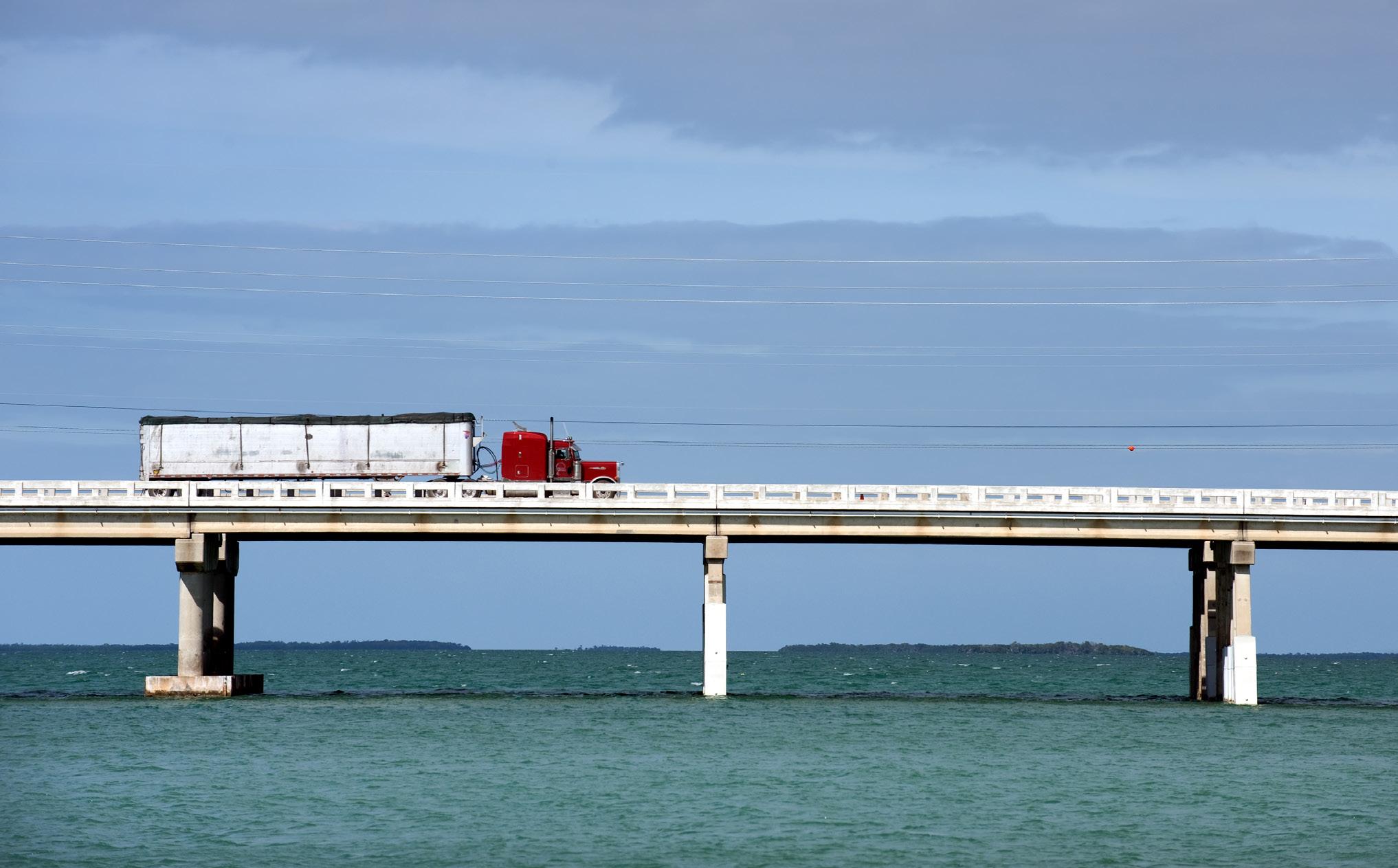



Position/Office
Construction Office
Design Office / District Design Engineer
District Freight & Seaport Coordinator
District MPO Liaison Administrator
District MPO Liaison (Charlotte County-Punta Gorda MPO & Sarasota/Manatee MPO)
District MPO Liaison (Lee County MPO, Collier MPO, & Heartland Regional TPO)
District MPO Liaison (Polk TPO)
Jon Sands
Kevin Ingle
Amanda Tyner
Wayne Gaither
Pamela Barr
Kristi Smith
Edith Perez
District Transit Programs Administrator Michelle Peronto
Federal Grant Coordinator Jhoanna Garces de Beltre
Local Program Administrator Lisa Brinson
Maintenance Office / District Maintenance Engineer Amarilys "Amy" Alfonso-Perez
Modal Development Manager
Planning Manager/Planning Studio
Paul Simmons
Vitor Suguri
Project Development & Environment Greg Browne (interim)
Traffic Operations / District Traffic Engineer Kevin Ingle (interim)
Additional information for this District can be found here.
E: jon.sands@dot.state.fl.us P: 863-519-2223
E: kevin.ingle@dot.state.fl.us P: 863-519-2740
E: amanda.tyner@dot.state.fl.us P: 863 519-2913
E: wayne.gaither@dot.state.fl.us P: 239-225-1971
E: pamela.barr@dot.state.fl.us P: 239-225-1928
E: kristi.smith@dot.state.fl.us P: 863-519-2265
E: edith.perez@dot.state.fl.us P: 863-519-2394
E: michelle.peronto@dot.state.fl.us P: 863-519-2551
E: jhoanna.garcesdebeltre@dot.state.fl.us P: 863-519-2911
E: lisa.brinson@dot.state.fl.us P: 863-519-2836
E: amarilys.perez@dot.state.fl.us P: 863-519-2315
E: paul.simmons@dot.state.fl.us P: 863-519-2388
E: vitor.suguri@dot.state.fl.us P: 863-221-1707
E: gregory.bowne@dot.state.fl.us P: 863-221-9197
E: kevin.ingle@dot.state.fl.us
P: 863-272-4366
5/1/2025



Position/Office
Community Planning Coordinator / District MPO Liaison Administrator (Gainesville MTPO)
Construction Office
Design Office
District MPO Liaison (North Florida TPO)
Federal Grant Coordinator / Planning and Environmental Management
Freight and Logistics Supervisor
Local Program Administrator
Maintenance Office
Project Development & Environment
Transportation Planning Manager
Traffic Operations
Urban Planning / Modal Development
Achaia Brown
Scott Lent
Kathy Thomas
Victoria Kutney
James Driggers
Kyle Coffman
Paul Webb
Carrie Stanbridge
Michael Brock
David Tyler
Jim Hannigan
Jim Knight
Additional information for this District can be found here
E: achaia.brown@dot.state.fl.us P: 904-360-5414
E: scott.lent@dot.state.fl.us P: 386-961-7730
E: kathy.thomas@dot.state.fl.us P: 386-961-7533
E: victoria.kutney@dot.state.fl.us P: 904-360-5668
E: james.driggers@dot.state.fl.us P: 386-758-3722
E: kyle.coffman@dot.state.fl.us P: 904-360-5686
E: paul.webb@dot.state.fl.us P: 386-961-7823
E: carrie.stanbridge@dot.state.fl.us P: 386-758-3744
E: michael.brock@dot.state.fl.us P: 386-961-7707
E: david.tyler@dot.state.fl.us P: 386-961-7842
E: jim.hannigan@dot.state.fl.us P: 386-961-7302
E: jim.knight@dot.state.fl.us P: 904-360-5646
5/1/2025



Position/Office
Construction Office
Design Office
District MPO Liaison Administrator
District MPO Liaison (Florida-Alabama TPO & Okaloosa-Walton TPO)
District MPO Liaison (Bay County TPO & Capital Region TPA)
Environmental Administrator
Federal Grant Coordinator / Local Program Administrator
Maintenance Office
Modal Development Manager
Passenger Operations Supervisor
Planning Manager
Public Transit Program Specialist
Traffic Operations
Kerrie Harrell
Adam Scurlock
Bryant Paulk
Christy Johnson
Kaylor Collins
John Whittington
Maria Showalter
Tim Hendrix
Scott Walters
Quinton Williams
Mark Brock
Debbie “Toni” Prough
Kim Toole
Additional information for this District can be found here
E: kerrie.harrell@dot.state.fl.us P: 850-330-1617
E: adam.scurlock@dot.state.fl.us P: 850-330-1400
E: bryant.paulk@dot.state.fl.us P: 850-981-2754
E: christy.johnson@dot.state.fl.us P: 850-981-2777
E: kaylor.collins@dot.state.fl.us P: 850-330-1488
E: john.whittington@dot.state.fl.us P: 850-330-1625
E: maria.showalter@dot.state.fl.us P: 850-330-1227
E: tim.hendrix@dot.state.fl.us P: 850-330-1681
E: scott.walters@dot.state.fl.us P: 850-330-1553
E: quinton.williams@dot.state.fl.us P: 850-330-1545
E: mark.brock@dot.state.fl.us P: 850-330-1536
E: debbie.prough@dot.state.fl.us P: 850-330-1558
E: kimberly.toole@dot.state.fl.us P: 850-330-1692
5/1/2025



Position/Office
Community Planning Coordinator
District Freight Coordinator
District MPO Liaison (Palm Beach TPA & Indian River County MPO)
District MPO Liaison (Martin MPO & St. Lucie TPO)
District MPO Liaison Supervisor (Broward MPO)
District Planning & Environmental Administrator
Federal Grant Coordinator / Freight and Logistics Manager
Local Program Administrator
Modal Development Office Administrator
Multi-Modal Coordinator
Passenger Operations Manager
Strategic Intermodal Systems Coordinator
Transit Coordinator
Larry Hymowitz
Justin Stroh
Marsha Taylor
Kelly Budhu
Tony Norat
Cesar Martinez
Carlos Castro
Mya Williams
Birgit Olkuch
Modeline Acreus
Lisa W. Maack
Ronald Kareiva
Stephanie Quintana
Additional information for this District can be found here.
E: larry.hymowitz@dot.state.fl.us P: 954-777- 4663
E: justin.stroh@dot.state.fl.us P: 954-777- 4517
E: marsha.taylor@dot.state.fl.us P: 954-777- 4401
E: kelly.budhu@dot.state.fl.us P: 954-777-4365
E: tony.norat@dot.state.fl.us P: 954-777- 4651
E: cesar.martinez@dot.state.fl.us P: 954-777-4653
E: carlos.castro@dot.state.fl.us P: 954 -777-4499
E: mya.williams@dot.state.fl.us P: 954-777- 4608
E: birgit.olkuch@dot.state.fl.us P: 954 -777-4689
E: modeline.acreus@dot.state.fl.us P: 954 -777-4490
E: lisa.maack@dot.state.fl.us P: 954 -777-4683
E: Ronald.kareiva@dot.state.fl.us P: 954 -77 -4441
E: stephanie.quintana@dot.state.fl.us P: 954 -777-4632
5/1/2025



Position/Office
Assistant District Construction Engineer
Aviation Coordinator
Community Planning Coordinator
Director of Operations
Director of Transportation Development
District Construction Engineer
Rafael Rodriguez
Joe Jerkins
James Rodriguez
Charles “Mike” Heffinger, Jr.
Jim Stroz
John Hatfield
District ETDM Coordinator Vacant
District Local Program Administrator
District Maintenance Engineer
Precious Lewis
Ron Meade
District Modal Administrator Vacant
District MPO Liaison Administrator (MetroPlan Orlando)
District MPO Liaison (Lake-Sumter MPO & Space Coast TPO)
District MPO Liaison (Ocala Marion TPO & River to Sea TPO)
District Scenic Highway Program Coordinator
Environmental Manager
5/1/2025
Jonathan Scarfe
Charles Koppernolle
Kia Powell
Alice Giuliani
Casey Lyon
E: rafael.rodriguez@dot.state.fl.us P: 386-743-5343
E: joseph.jerkins@dot.state.fl.us P: 386-943-5040
E: james.rodriguez@dot.state.fl.us P: 386-943- 5457
E: charles.heffinger@dot.state.fl.us P: 386-943-5477
E: jim.stroz@dot.state.fl.us P: 386-624-4116
E: john.hatfield@dot.state.fl.us P: 386-943-5344
E: precious.lewis@dot.state.fl.us P: 386-943- 5153
E: ron.meade@fot.state.fl.us P: 386-943- 5277
E: jonathan.scarfe@dot.state.fl.us P: 386-943-5791
E: charles.koppernolle@dot.state.fl.us P: 386-943-5185
E: kia.powell@dot.state.fl.us P: 386-943-5499
E: alice.giuliani@dot.state.fl.us P: 386-943-5247
E: casey.lyon@dot.state.fl.us P: 386-943-5436

Additional information for this District can be found here. Position/Office
Federal Grant Coordinator Alice Giuliani
Freight and Logistics Manager
Freight, Seaport, & Spaceport Coordinator
Modal Development Transit Grant Coordinator
Allison McCuddy
Sarah Van Gundy
Carlos Colon
Multimodal Coordinator Paul Schoelzel
Passenger Operations Manager Libertad Acosta-Anderson
Planning and Environmental Management Administrator
Kellie Smith
Project Development Administrator Steven Buck
Rail Administration Manager David Cooke
Systems Planning Supervisor Tiffany Hill
Transit Intermodal Supervisor Jo Santiago-Mercer
Transportation Planning Manager Melissa McKinney
5/1/2025
E: alice.giuliani@dot.state.fl.us P: 386-943-5247
E: allison.mccuddy@dot.state.fl.us P: 386-943-5041
E: sarah.vangundy@dot.state.fl.us P: 386-943-5026
E: carlos.colon@dot.state.fl.us P:321-319-8173
E: paul.schoelzel@dot.state.fl.us P: 386-943-5246
E: libertad.acostaanderson@dot.state.fl.us P: 386-943-5410
E: kellie.smith@dot.state.fl.us P: 386-943-5427
E: steven.buck@dot.state.fl.us P: 386-943-5171
E: david.cooke@dot.state.fl.us P: 386-943-5107
E: tiffany.hill@dot.state.fl.us P: 386-943-5421
E: jo.santiago@dot.state.fl.us P: 321-319-8175
E: melissa.mckinney@dot.state.fl.us P: 386-943-5077



Position/Office
Community Planning Coordinator
Construction Office
Design Office
Federal Grant Coordinator / District Freight Coordinator
District MPO Liaison (Miami-Dade TPO)
District Planning and Environmental Administrator
Local Program Administrator
Maintenance Office
Modal Development Administrator
Passenger Operations Manager
Traffic Operations
Shereen Yee Fong
Mario Cabrera
Karina Fuentes
Sandra Villard
Tellis Baker
Dat Huynh
Jessica Beck-Galindo
Renato Marrero
Nilia Cartaya
Raymond Freeman
Omar Meitin
Transportation Planning Manager Ken Jeffries
Additional information for this District can be found here.
E: shereen.yeefong@dot.state.fl.us P: 305-470-5393
E: mario.cabrera@dot.state.fl.us P: 305-640- 7445
E: karina.fuentes@dot.state.fl.us P: 305-470- 5310
E: sandra.villard@dot.state.fl.us P: 305-470-5238
E: tellis.baker@dot.state.fl.us P: 305-470- 5408
E: dat.huynh@dot.state.fl.us P: 305-470- 5201
E: jessica.beck-galindo@dot.state.fl.us P: 305-470- 5404
E: renato.marrero@dot.state.fl.us P: 305-470- 5359
E: nilia.cartaya@dot.state.fl.us P: 305-640-7557
E: raymond.freeman@dot.state.fl.us P: 305-470- 5255
E: omar.meitin@dot.state.fl.us P: 305-470- 5312
E: ken.jeffries@dot.state.fl.us P: 305-470-5445
5/1/2025



Position/Office
Community Planning Coordinator
Construction Office
Design Office
District Freight Coordinator
Government Liaison (Hernando/Citrus MPO & Hillsborough TPO)
Government Liaison (Pasco County MPO & Forward Pinellas)
Government Liaison Manager
Federal Grant Coordinator / Transportation Planning Manager
Local Program Administrator
Maintenance Office
Modal Development Administrator
Project Development & Environment
Traffic Operations
Traffic Safety
Transit & Intermodal Administrator
Daniel Santos
Conrad Campbell
Allan Urbonas
Mike Brown
Elisa Joyner
Caron Watkins
Suzanne Ziegler
Brian Hunter
Sara Clark
Jason Boulnois
Ming Gao
Kirk Bogen
Ron Chin
Emmeth Duran
Chris Leffert
Additional information for this District can be found here
5/1/2025
E: daniel.santos@dot.state.fl.us P: 813-975- 6429
E: conrad.cambell@dot.state.fl.us P: 813-975- 6294
E: allan.urbonas@dot.state.fl.us P: 813-975- 6178
E: michael.brown@dot.state.fl.us P: 813-975- 6643
E: elisa.joyner@dot.state.fl.us P: 813-975- 6449
E: caron.watkins@dot.state.fl.us P: 813-975- 6432
E: suzanne.ziegler@dot.state.fl.us P: 813-975-6721
E: brian.hunter@dot.state.fl.us P: 813-975-6436
E: sara.clark@dot.state.fl.us P: 813-975- 6439
E: jason.boulnois@dot.state.fl.us P: 813 -975-6264
E: ming.gao@dot.state.fl.us P: 813-975- 6454
E: kirk.bogen@dot.state.fl.us P: 813-975-6448
E: ronald.chin@dot.state.fl.us P: 813-975- 6253
E: emmeth.duran@dot.state.fl.us P: 813-975-6124
E: chris.leffert@dot.state.fl.us P: 813-975-6403

Position/Office Contact Contact Information
Construction Office
Design Office
Maintenance Office
MPO Liaison – Central/West Florida
MPO Liaison – South Florida
Planning Manager/Community Planning Coordinator
Planning & Environmental Management Administrator
Project Development & Environment
Traffic Operations
Turnpike Utility & Rail Administrator
Albert Salas
Moataz “Mo” Hassan
Debbie Meyer
Siaosi Fine
James Brown, Jr.
Katina Kavouklis
Carol Scott
Henry Pinzon
John Easterling
Joe Bitar
Additional information for this District can be found here.
E: albert.salas@dot.state.fl.us P: 954-934-1113
E: moataz.hassan@dot.state.fl.us P: 407-264-3988
E: debbie.meyer@dot.state.fl.us P: 954-934-1228
E: siaosi.fine@dot.state.fl.us P: 407-264-3494
E: james.brownjr@dot.state.fl.us P: 407-934-1293
E: carol.scott@dot.state.fl.us P: 407-264-3808
E: carol.scott@dot.state.fl.us P: 407-264-3023
E: henry.pinzon@dot.state.fl.us P: 407-264-3802
E: john.easterling@dot.state.fl.us P: 954-934-1620
E: joe.bitar@dot.state.fl.us P: 407-264-3007
5/1/2025